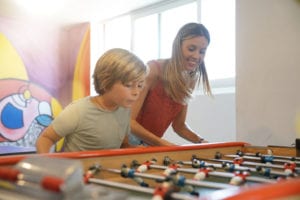Nothing says fun indoor games for the family more than home game room products. In this special at-home feature, we’re taking a look at popular games that have been altered to make playing at home more fun, and they’re also kid-friendly
Perhaps you’re one of the many families who have played all the games in your home game room so much that you don’t even wanna look at them anymore. You might be experiencing A.H.B. (At Home Boredom) and are searching for ways to reignite the fun. Don’t fear…Games For Fun is here to help bring you a roomful of entertainment in your time of need!
What we’ve learned during the pandemic is that there are ways to stay entertained even when the entertainment gets, well, stale, to say the least. One of the easiest and most effective ways we’ve been able to combat at-home boredom is by tapping into our creative side with unique twists on popular indoor games. By adding or removing a rule, your home game room can take on an entirely new personality! In part 1 of this article, we’ll be talking about variations of billiards, foosball, and ping-pong. And in part 2, we’ll be talking about air hockey, shuffleboard, and darts. You name it, we’re playing it!
Teach the Family How to Play A Game of Billiards At Home…With A Korean Twist
We’ve written about billiards before. This game might be considered a “simple” game to play in homes all across America, and that’s why that billiard table might be collecting dust as we speak. But adding a cultural twist to this well-known pastime could give you a run for your money. Korean billiards, known as “danggu” in Korea, isn’t really what you would call a “simple” or “popular” game in America. In fact, there’s a general lack of danggu tables in this country.
Traditionally, this four-ball billiards or four-ball carom is played on a pocketless table with four billiard balls, usually two red and two white, one of the latter with a spot to distinguish it (in some sets, one of the white balls is yellow instead of spotted). However, this article explains that this version of the game is played with two red object balls, one white cue ball, and one yellow cue ball (or sometimes both cue balls are white, with one having a red spot).
Each of the two players is assigned a white or yellow cue ball; whether the opponent can use it as an object ball is a difference between the version you want to play. A point is scored when the shooter caroms on two balls. A carom on only one ball results in no points and ends the shooter’s inning.
How can you recreate this game at home? Your pool table could be used in the place of the danggu table. American billiards requires players to knock the pool balls into six evenly placed pockets. In danggu, two white cue balls and two red balls are used on a table similar to an American pool table — but with no pockets. To achieve this “pocketless” table, simply stuff the pool table pockets with some sort of cloth to block the balls from going in, or place disposable cups upside down on the pockets to cover them. To keep the cups from moving around, tape them down if they don’t fit snug. A yellow ball can replace one of the white cue balls to avoid confusion.
If a player hits both red balls on a single hit with one of the cue balls, the player receives one point. A player is allowed to continue to hit until he or she misses a ball. A wooden box mounted on the wall with score chips helps keep score. Chips are deducted from the amount set at the beginning of the game.
Another great thing about this game is that the number of people allowed to play doesn’t matter, as long as it’s an even number. So the whole family could play! If there’s an uneven number, you can do rounds and the winner can play the next family member.
When the Family Is Bored at Home Try This Foosball Game Variation
Multiball foosball is basically the same as standard foosball, except instead of 1 ball being served, multiple balls are served each time. In this case, 3 balls are served each time. A point is given to the person who scores the most goals. Only 1 point is given each time, even if one player scores all three goals. The game progresses until someone reaches 10 points.
Wanna add more crazy to the already-crazy? Introduce the idea of Crazy Multiball to the family. In this game, you layout maybe 9 or 11 balls at the center (you can use as many balls as you want, but really it needs to be an odd number to avoid ties.) After a countdown from 3, the players try to get as many of the balls as they can into the opponent’s goals. The winning player is the one who scores the most goals.
Some more ways you could make this game even more fun is by using weighted balls to increase the overall challenge of the game or try playing a one-handed game where each player can only use one hand of choice and hands cannot be swapped during a game.
Ping-pong for Kids vs. Ping-pong (After Hours)
The name in itself is already fun, but start incorporating some new rules and it takes this traditional table game to the next level. Let’s start off with the kid-friendly variation of ping-pong. Rotating ping-pong requires a minimum of three players. The players respectively position themselves on either side of the table. The side with more players is the first to serve.
The principle of the game is to hit the ball while circling the table. When a player misses a ball, the latter lays his or her paddle on the table. If a player who is still in the game bounces the ball on the bat, the eliminated player can rejoin the game. Once there are no more than two players, they get involved in a match to decide the winner.
If your family is composed of all adults, or maybe the kids have gone to bed, here’s a rather popular version of ping-pong: beer pong! The idea of this variation is to throw a ping-pong ball into a plastic cup filled with drink, which your opponents then have to drink. Essentially, each time the ball lands inside the cup, the opposing team has to drink its contents. The cups are positioned in a triangle on both sides of the ping-pong table and must be touching. The player designated to shoot keeps his or her elbow behind the edge of the table. It’s possible to replace the cups at any point in the game. All you have to do is position the cups where they would have been if they hadn’t slipped over.
To add more variation to this game, fill the cups with various beverages (water, iced tea, beer, vodka, apple juice, and more). The team which manages to reach all the opposing team’s cups wins the game. As a tip, opt for an outdoor ping-pong table, which is much more hard-wearing and suited to such ‘boozy’ leisure pursuits. You could still use it indoors, it’s just likely to last longer since it’s built to withstand the conditions of the outdoors.
Indoor Family Games Don’t Stop, They Only Get More Creative
Between Korean billiards, multi foosball, and rotating, beer-drinking ping-pong which game variation was your favorite? Which one are you most excited to try at home? Remember that being at home doesn’t mean you can’t have fun as a family!
For more inspiration on how to have fun, check out the Games For Fun blog. Each month, we discuss various gaming topics from home game room ideas to popular games you can play in the fall. And be sure to stay tuned for the second part of this blog where we’ll be talking about ways to make air hockey, shuffleboard, and darts more fun when playing at home. You name it, playing it (after we give it a lil’ twist for extra fun).



